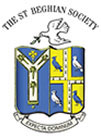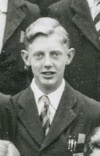|
 |
The Old St Beghian | |
| July 2018 | |||
Basil Mawdsley (G 43-47)
Sheila Pugh has contributed the following:
“Arundel James Basil Mawdsley was born in St Helens on 22 April 1930 to Sybil a teacher, and Arundel, a Prescot District Council rate and rent collector, and church organist. During his early life, Basil recalled enjoying the company of three of the family’s Cairn terriers, all called ‘Jock’, a fondness which he retained into later life.
It was whilst he was at St Bees that Basil’s aptitude for numbers and a love of sport were nurtured. It was also during this time there, spanning the Second World War, which saw the untimely death of his father.In the late 1940s he played rugby at Waterloo RUFC, where E.G.R. Millais (F 44-49) played. L.D. Hayward (FS 42-47) and Basil also played for Liverpool Leopards, a scratch, 7-aside team of those articled to chartered accountants in the Liverpool area - they were thoroughly trounced by the solicitors’ equivalent, most of whom played at Waterloo RUFC.
On leaving St Bees, Basil spent the next five years articled with a medium-sized firm of chartered accountants in Liverpool, qualifying in early 1953. This enabled him to defer his National Service until September of that year, when he joined the British army.
He initially spent a few weeks at Catterick, then at Mons Officer Cadet School, Aldershot, during which time he and others were ‘polished’ by the famous Sergeant Major Brittain. On return to Catterick, Basil was commissioned as troop commander, 6 Training Regiment, The Royal Signals, at Beverley, East Yorkshire, where he took up cricket again, becoming captain of the regimental side. He was disappointed not to have joined a front line unit abroad, eventually leaving the army in September 1955. However, the army had not done with Basil, and he was obliged to remain in the Territorial Reserve for two years, the highlight of which was being put on ten days’ notice to fly to Cyprus amid the Suez crisis of 1956.
In April 1955, Basil married Enid, and three children - Gillian, Elaine and Alistair - soon followed at two-year intervals from 1957.
Out of the army, Basil joined a small firm of accountants in St Helens before embarking on a career in commerce that began on Merseyside before his first major posting to Ford’s in Dagenham in 1963, requiring a move to Essex.
A series of management roles culminated in his becoming one of two finance managers at the company’s new works at Halewood, coincidentally only a few miles from where he grew up.After a year in management consultancy at Tyzack and Partners, the next big move was to Fife in 1966 to Nairn Williamson, the floor and wall coverings company, where Basil forged business contacts that he took forward in his later career, and where the seaside life saw him develop his interest in dinghy sailing at Lower Largo sailing club (he made his own wetsuit). A fourth child, Timothy, arrived just in time for the move north. His children fondly remember running through the dunes separating their house and the sea just yards away, and Tim grew up with a Scottish accent.
A journey south to Surrey saw Basil join the construction materials specialist Tunnel Holdings in 1971 as Group Finance Director for the next decade. In 1982, he became Finance Director at International Thomson Organisation, and then in 1984 at the House of Fraser group, overseeing among other operations, Harrods, eventually working for the Al Fayeds after their successful takeover of the group. After this, a role at the National Heritage Memorial Fund rounded off his working life as the 1980s came to a close. In the mid-1970s Basil met Sheila, who was to become his Partner for the rest of his life.
Basil was far from idle after his business career came to an end, and he embarked on the project of renovating a late 17c. farmhouse south of the Lot Valley in South-West France, installing a swimming pool and enough modern conveniences to make it a happy holiday home of which both he and Sheila could be proud. And what better place could there be for someone who knew and enjoyed wine and the delights of French gastronomy to spend his retirement? The pages of the information book that they left in the house for visitors were full of details of local restaurants, at which they were well known and welcomed patrons.And throughout this period he had time to pursue his other interests, which included top-class rugby, visits to the opera, ballet, the Chelsea Flower Show, fine restaurants, and collecting antique maps. He also engaged actively with London Branch OSB functions, and particularly enjoyed his involvement with the 1997 Dinner in the pavilion at Lord’s Cricket Ground, which marked the 25th anniversary of his membership of the MCC and the 50th anniversary of his leaving St Bees. Also, of course, as a member of the MCC, he could regularly be found under his panama sporting his egg and bacon tie, at the end of the same row of the upper deck of the Warner Stand at Lord’s, typically playing host to friends and family with a three-course lunch, a chilled white and a decent claret.
Sadly, over the last few years these pleasures began to be denied him due to increasing health problems but thanks to Sheila, and with the help of good carers, he was able to remain at home.
He himself would no doubt look back and say they were all ‘marvellous’ and evidence of a full life well lived.”
Home
The St Beghian Society
St Bees School,
St Bees, Cumbria, CA27 0DS.
Tel: (01946) 828093 Email: osb@stbeesschool.co.uk
Web: www.st-beghian-society.co.uk
![]()

.jpg)
 (400).jpg)